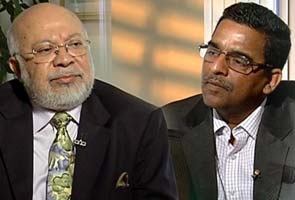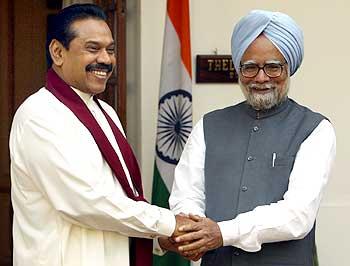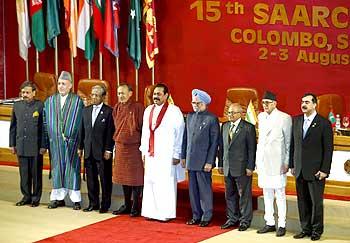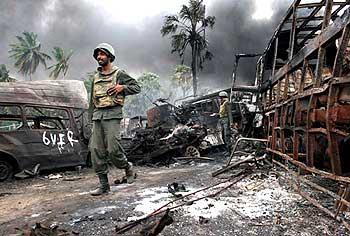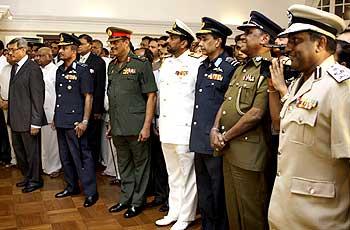For the past decade or so, much of Indian strategic thinking and discourse has visibly shifted from its Pakistan-centric focus to study Sino-Indian relations. The rise of China and its implications for India is now a preferred area of serious study.
 At the same time Chinese inroads into India's strategic neighbourhood, Beijing's continuing attempts to use Pakistan's as cat's paw against India and New Delhi's balancing act of evolving a strategic partnership with the United States even while keeping a dialogue going with China are some of the highlights of the past decade. Many authors write about India-China relations, the emerging US-India-Japan trilateral compact but there are very few authoritative and knowledgeable Indian writers who have a deep insight into Chinese strategic thinking and the internal dynamics within China.
At the same time Chinese inroads into India's strategic neighbourhood, Beijing's continuing attempts to use Pakistan's as cat's paw against India and New Delhi's balancing act of evolving a strategic partnership with the United States even while keeping a dialogue going with China are some of the highlights of the past decade. Many authors write about India-China relations, the emerging US-India-Japan trilateral compact but there are very few authoritative and knowledgeable Indian writers who have a deep insight into Chinese strategic thinking and the internal dynamics within China.
Jayadeva Ranade, a former Additional Secretary in India's Cabinet Secretariat, an euphemism for the country's external intelligence agency, the Research and Analysis Wing (RAW), is one such analyst. A frequent writer in leading newspapers and regular panelist on Indian Television channels, Ranade was also associated with the Centre for Airpower Studies (CAPS) for a couple of years after he retired from active service. As the foremost China hand in RAW, Ranade was engaged in keeping a close watch on day to day developments around China and its implications for India.
After retirement however he was not constrained by the compulsions of government policies and requirement. Freed of encumbrances, Ranade has utilised the luxury of being an independent analyst in his post-retirement writings for CAPS as well as for different newspapers. The sum total of all his writings in the 2010-2012 period has resulted in a book China Unveiled: Insights into Chinese Strategic Thinking (KW Publishers: ISBN 978-93-81904-43-5).
Released by National Security Adviser (NSA) Shiv Shankar Menon, himself a China thinker, the book is a valuable asset for every serious student of China. Ranade's vast experience in dealing with China both from the ground (he was in Beijing when the Tiananmen Square incident happened in 1989) and from his perch as the leading analyst in the agency, shines through the book.
Unlike most Indian writers, Ranade has chosen to write on China and Chinese leadership as a standalone subject rather than through the prism of Sino-Indian dynamic. So you have a great insight into Hu Jintao's rise and his real power. By tracing his roots, his rise and his tenure through little known facts, Ranade draws a completely refreshing profile of Hu, who has just handed over the reins of power to Xi Jingping. In the first chapter Hu's in charge? Ranade states "though Hu's tenure has been dogged by comments that he is not powerful as his predecessors, his career path shows otherwise. It is likely that Hu Jintao's influence will, in fact, continue to linger well after he steps down from office (January 2011)."
In less than three months after profiling Hu Jintao, Ranade wrote at length on Xi Jingping in the chapter China's Next Chairman: Xi Jingping. And again broughtout unknown facts and anecdotes. His prognosis of Xi's likely stand (March 2011)--"What can be inferred with reasonable surety is that Xi Jinping’s military affiliations and pronounced linkages with senior PLA officers will influence his policies. The military will receive high budgetary allocations and the focus on the PLA’s modernisation will continue. ‘Integrated joint operations’ and preparations for fighting ‘short duration regional wars under hi-tech informatised conditions’ will remain a feature. He is likely to stay with the current policy, which combines diplomacy with a strong suggestion of military muscle"--is bang on. All developments in recent months after Xi has formally taken over confirms what Ranade predicted two years ago!
The strength of this compilation in fact remains in its accurate prognosis.
For instance in the chapter entitled India and China: The way forward (December 2010) he correctly assesses how the relationship will pan out. "India-China relations specifically need to be viewed in this backdrop. The Chinese leadership’s view of India is significant. While discussing India in interactions with foreign strategists and diplomats, Chinese officials and members of Chinese government-controlled think-tanks list three main items as issues of concern. These are, in the Chinese-listed order of priority: the Dalai Lama and Tibet issue; the border dispute; and India’s geopolitical ambitions. These can be classified as tactical and short-term, medium-to-long term and strategic.
"For example, during the US-China Strategic Dialogue in Washington a few months ago, when the US proposed a US-China-India trilateral, China vehemently rejected the
idea and questioned how the US could place India anywhere near on par with China when the two were not at all comparable. Noteworthy also is the omission by China of vital natural resource issues like water and food, which will become serious factors that bedevil the relationship in the next ten to fifteen years."
China's new leader Xi Jingping and Prime Minister Manmohan Singh in fact met at Durban during the BRICS summit in South Africa on 27 March 2013. Just days before that meeting the Chinese had suggested a five point formula to take forward the Sino-Indian relationship. Much of the proposal is old but it very much resembles what Ranade said over two years ago!
Although the book deals with a range of subjects, its main focus remains contemporary China. The 32 essays that comprise the book presents a comprehensive 360 degree look at present day China dealing with subjects ranging from rapid modernisation of the PLA, the changing nature of China's Communist Party, environment to China's maritime ambitions and cyber strategy.
If there is one drawback in the book that serious scholars of India-China relationship will complain about is the lack of citations and references. But as the publishers and author himself have clarified, the book is meant as an easy reading and not a heavy tome full of notes and index!
Anyone interested in today's China, must read this book if only to understand the complex challenge that the middle kingdom poses to strategic thinkers.
 At the same time Chinese inroads into India's strategic neighbourhood, Beijing's continuing attempts to use Pakistan's as cat's paw against India and New Delhi's balancing act of evolving a strategic partnership with the United States even while keeping a dialogue going with China are some of the highlights of the past decade. Many authors write about India-China relations, the emerging US-India-Japan trilateral compact but there are very few authoritative and knowledgeable Indian writers who have a deep insight into Chinese strategic thinking and the internal dynamics within China.
At the same time Chinese inroads into India's strategic neighbourhood, Beijing's continuing attempts to use Pakistan's as cat's paw against India and New Delhi's balancing act of evolving a strategic partnership with the United States even while keeping a dialogue going with China are some of the highlights of the past decade. Many authors write about India-China relations, the emerging US-India-Japan trilateral compact but there are very few authoritative and knowledgeable Indian writers who have a deep insight into Chinese strategic thinking and the internal dynamics within China. Jayadeva Ranade, a former Additional Secretary in India's Cabinet Secretariat, an euphemism for the country's external intelligence agency, the Research and Analysis Wing (RAW), is one such analyst. A frequent writer in leading newspapers and regular panelist on Indian Television channels, Ranade was also associated with the Centre for Airpower Studies (CAPS) for a couple of years after he retired from active service. As the foremost China hand in RAW, Ranade was engaged in keeping a close watch on day to day developments around China and its implications for India.
After retirement however he was not constrained by the compulsions of government policies and requirement. Freed of encumbrances, Ranade has utilised the luxury of being an independent analyst in his post-retirement writings for CAPS as well as for different newspapers. The sum total of all his writings in the 2010-2012 period has resulted in a book China Unveiled: Insights into Chinese Strategic Thinking (KW Publishers: ISBN 978-93-81904-43-5).
Released by National Security Adviser (NSA) Shiv Shankar Menon, himself a China thinker, the book is a valuable asset for every serious student of China. Ranade's vast experience in dealing with China both from the ground (he was in Beijing when the Tiananmen Square incident happened in 1989) and from his perch as the leading analyst in the agency, shines through the book.
Unlike most Indian writers, Ranade has chosen to write on China and Chinese leadership as a standalone subject rather than through the prism of Sino-Indian dynamic. So you have a great insight into Hu Jintao's rise and his real power. By tracing his roots, his rise and his tenure through little known facts, Ranade draws a completely refreshing profile of Hu, who has just handed over the reins of power to Xi Jingping. In the first chapter Hu's in charge? Ranade states "though Hu's tenure has been dogged by comments that he is not powerful as his predecessors, his career path shows otherwise. It is likely that Hu Jintao's influence will, in fact, continue to linger well after he steps down from office (January 2011)."
In less than three months after profiling Hu Jintao, Ranade wrote at length on Xi Jingping in the chapter China's Next Chairman: Xi Jingping. And again broughtout unknown facts and anecdotes. His prognosis of Xi's likely stand (March 2011)--"What can be inferred with reasonable surety is that Xi Jinping’s military affiliations and pronounced linkages with senior PLA officers will influence his policies. The military will receive high budgetary allocations and the focus on the PLA’s modernisation will continue. ‘Integrated joint operations’ and preparations for fighting ‘short duration regional wars under hi-tech informatised conditions’ will remain a feature. He is likely to stay with the current policy, which combines diplomacy with a strong suggestion of military muscle"--is bang on. All developments in recent months after Xi has formally taken over confirms what Ranade predicted two years ago!
The strength of this compilation in fact remains in its accurate prognosis.
For instance in the chapter entitled India and China: The way forward (December 2010) he correctly assesses how the relationship will pan out. "India-China relations specifically need to be viewed in this backdrop. The Chinese leadership’s view of India is significant. While discussing India in interactions with foreign strategists and diplomats, Chinese officials and members of Chinese government-controlled think-tanks list three main items as issues of concern. These are, in the Chinese-listed order of priority: the Dalai Lama and Tibet issue; the border dispute; and India’s geopolitical ambitions. These can be classified as tactical and short-term, medium-to-long term and strategic.
"For example, during the US-China Strategic Dialogue in Washington a few months ago, when the US proposed a US-China-India trilateral, China vehemently rejected the
idea and questioned how the US could place India anywhere near on par with China when the two were not at all comparable. Noteworthy also is the omission by China of vital natural resource issues like water and food, which will become serious factors that bedevil the relationship in the next ten to fifteen years."
China's new leader Xi Jingping and Prime Minister Manmohan Singh in fact met at Durban during the BRICS summit in South Africa on 27 March 2013. Just days before that meeting the Chinese had suggested a five point formula to take forward the Sino-Indian relationship. Much of the proposal is old but it very much resembles what Ranade said over two years ago!
Although the book deals with a range of subjects, its main focus remains contemporary China. The 32 essays that comprise the book presents a comprehensive 360 degree look at present day China dealing with subjects ranging from rapid modernisation of the PLA, the changing nature of China's Communist Party, environment to China's maritime ambitions and cyber strategy.
If there is one drawback in the book that serious scholars of India-China relationship will complain about is the lack of citations and references. But as the publishers and author himself have clarified, the book is meant as an easy reading and not a heavy tome full of notes and index!
Anyone interested in today's China, must read this book if only to understand the complex challenge that the middle kingdom poses to strategic thinkers.
